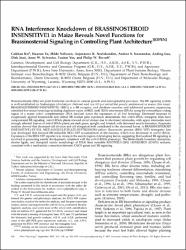| dc.contributor.author | Kir, Gokhan | |
| dc.contributor.author | Ye, Huaxun | |
| dc.contributor.author | Nelissen, Hilde | |
| dc.contributor.author | Neelakandan, Anjanasree K. | |
| dc.contributor.author | Kusnandar, Andree S. | |
| dc.contributor.author | Luo, Anding | |
| dc.contributor.author | Inze, Dirk | |
| dc.date.accessioned | 2019-11-24T20:58:54Z | |
| dc.date.available | 2019-11-24T20:58:54Z | |
| dc.date.issued | 2015 | |
| dc.identifier.issn | 0032-0889 | |
| dc.identifier.issn | 1532-2548 | |
| dc.identifier.uri | https://dx.doi.org/10.1104/pp.15.00367 | |
| dc.identifier.uri | https://hdl.handle.net/20.500.12513/3179 | |
| dc.description | WOS: 000360930600062 | en_US |
| dc.description | PubMed ID: 26162429 | en_US |
| dc.description.abstract | Brassinosteroids (BRs) are plant hormones involved in various growth and developmental processes. The BR signaling system is well established in Arabidopsis (Arabidopsis thaliana) and rice (Oryza sativa) but poorly understood in maize (Zea mays). BRASSINOSTEROID INSENSITIVE1 (BRI1) is a BR receptor, and database searches and additional genomic sequencing identified five maize homologs including duplicate copies of BRI1 itself. RNA interference (RNAi) using the extracellular coding region of a maize zmbril complementary DNA knocked down the expression of all five homologs. Decreased response to exogenously applied brassinolide and altered BR marker gene expression demonstrate that zmbriI-RNAi transgenic lines have compromised BR signaling. zmbriI-RNAi plants showed dwarf stature due to shortened internodes, with upper internodes most strongly affected. Leaves of zmbriI-RNAi plants are dark green, upright, and twisted, with decreased auricle formation. Kinematic analysis showed that decreased cell division and cell elongation both contributed to the shortened leaves. A BRASSINOSTEROID INSENSITIVE1-ETHYL METHANESULFONATE-SUPPRESSOR1-yellow fluorescent protein (BES1-YFP) transgenic line was developed that showed BR-inducible BES1-YFP accumulation in the nucleus, which was decreased in zmbriI-RNAi. Expression of the BES1-YFP reporter was strong in the auricle region of developing leaves, suggesting that localized BR signaling is involved in promoting auricle development, consistent with the zmbriI-RNAi phenotype. The blade-sheath boundary disruption, shorter ligule, and disrupted auricle morphology of RNAi lines resemble KNOTTED1-LIKE HOMEOBOX (KNOX) mutants, consistent with a mechanistic connection between KNOX genes and BR signaling. | en_US |
| dc.description.sponsorship | Iowa State University Plant Sciences Institute; Genetics, Development, and Cell Biology Department; Ministry of National Education, Republic of TurkeyMinistry of National Education - Turkey | en_US |
| dc.description.sponsorship | This work was supported by the Iowa State University Plant Sciences Institute and the Genetics, Development, and Cell Biology Department and by the Ministry of National Education, Republic of Turkey (education fellowship to G.K.). | en_US |
| dc.language.iso | eng | en_US |
| dc.publisher | AMER SOC PLANT BIOLOGISTS | en_US |
| dc.relation.isversionof | 10.1104/pp.15.00367 | en_US |
| dc.rights | info:eu-repo/semantics/openAccess | en_US |
| dc.title | RNA Interference Knockdown of BRASSINOSTEROID INSENSITIVE1 in Maize Reveals Novel Functions for Brassinosteroid Signaling in Controlling Plant Architecture | en_US |
| dc.type | article | en_US |
| dc.relation.journal | PLANT PHYSIOLOGY | en_US |
| dc.contributor.department | Kırşehir Ahi Evran Üniversitesi, Mühendislik-Mimarlık Fakültesi, Genetik ve Biyomühendislik Bölümü | en_US |
| dc.identifier.volume | 169 | en_US |
| dc.identifier.issue | 1 | en_US |
| dc.identifier.startpage | 826 | en_US |
| dc.identifier.endpage | + | en_US |
| dc.relation.publicationcategory | Makale - Uluslararası Hakemli Dergi - Kurum Öğretim Elemanı | en_US |


















